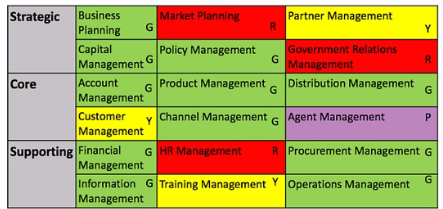Consider the following business capability model. there cells of a model are given different colors to represent desired maturity levels (Green (G) - level achieved, yellow (Y) = one level away, red (R) -two more more levels away, purple (P) = missing capability):
Correct Answer:
C
This answer is based on the color-coding of the business capability model, which indicates the desired maturity levels of each capability. Red cells mean that the capability is two or more levels away from the desired maturity level, yellow cells mean that the capability is one level away, green cells mean that the capability has achieved the desired maturity level, and purple cells mean that the capability is missing or not defined. According to this logic, the capabilities that need immediate attention are those that are red, which are Customer Management, Training Management and Partner Management. The capabilities that need attention are those that are yellow, which are Market Planning, HR Management and Government Relations Management. The capability that is missing as a Core capability is Agent Management, which is purple. The rest of the capabilities are green, which means they have reached the desired maturity level.


